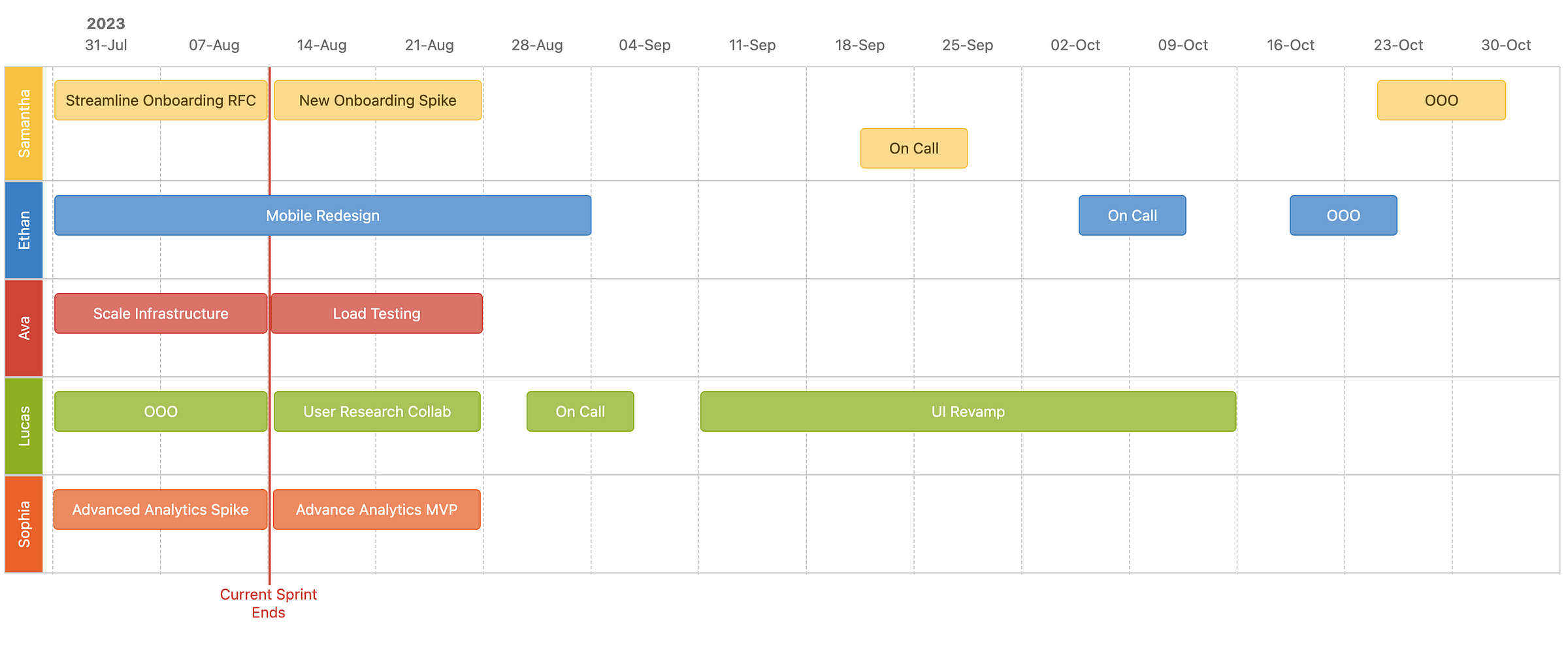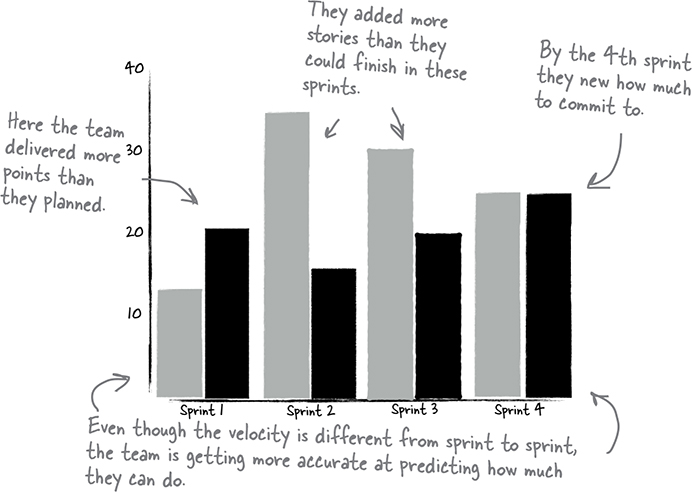How To Run Effective Sprint Planning Sessions
29 Jul 2023A Step-by-Step Sprint Planning Guide for Engineering Leaders
 Sprint Planning Meeting from Classic Programmer Paintings
Sprint Planning Meeting from Classic Programmer Paintings
If you’ve been an engineer for some amount of time in the tech industry, you have probably experienced the highs and lows of sprint planning meetings. Maybe it has felt a bit like this painting by Marie Bashkirtseff. I’ve personally been in the trenches, both as a participant and as a leader, and have witnessed the wide array of approaches and their varying levels of effectiveness. It became apparent to me that the success of sprint planning lies in finding a structured and efficient approach that aligns the team and maximizes productivity.
Sprint planning is the backbone of Scrum-based agile project management, providing the framework for teams to organize their work and establish clear goals for each iteration. Yet, all too often, I’ve seen these meetings devolve into chaos, resulting in misaligned priorities and a waste of valuable time. Recognizing the need for a better way, I embarked on a journey to refine and iterate upon a process that consistently delivers exceptional results.
Through countless iterations and learnings, I’ve developed a process that has significantly improved the effectiveness of sprint planning while keeping the meeting overhead low. This process has helped my teams regain focus, enhance collaboration, and achieve remarkable outcomes.
In this article, I aim to share my insights and provide you with a step-by-step guide to streamline your own sprint planning, ensuring that it becomes a powerful tool for success.
Principles
Before we go any further, I will state this is an opinionated view on sprint planning and it follows these four underlying principles:
- Bulk of the sprint planning happens 2 weeks leading up to the sprint start: Allotting adequate time for gathering requirements, aligning priorities, and preparing for the upcoming work is vital. This two-week timeframe allows for thorough preparation and sets the stage for a successful sprint.
- Sprint planning session is mainly for high-level sprint review and alignment: The sprint planning session itself should primarily focus on reviewing the high-level aspects of the upcoming sprint and ensuring alignment with the team’s goals. Detailed discussions and refinement of tasks should occur prior to the planning session.
- Each team member is an owner and driver of their work stream: Engineers are not “ticket takers” but leaders who take responsibility for problem definition and own end-to-end execution. Consequently, each team member is responsible for creating tickets and breaking down work into manageable chunks, ensuring a proactive and self-driven approach.
- Tickets in the sprint are conscious commitments to deliver: The team takes a proactive and accountable approach to managing workload. Promptly flag any potential delays, emergent work, or setbacks and involve the stakeholders to renegotiate commitments in alignment with the evolving circumstances. It’s crucial to avoid scope creep during the sprint. If new tasks or requirements emerge mid-sprint, renegotiate commitments for existing work rather than merely piling new tasks on top.
Prerequisites
Before diving into the tactical sprint planning process, there are a few prerequisites that need to be in place:
- Long-term roadmap for your team: Having a clear vision of your team’s long-term goals and initiatives is essential. This roadmap will serve as a guide for prioritizing work during sprint planning, ensuring that each sprint contributes to the broader objectives. If you don’t have this, at minimum having OKRs is important so that everyone is aligned at a high level on how the day-to-day work ladders up to more overarching business (or mission) objectives.
- JIRA plan of Epics: Use a project management tool like JIRA to create a plan and map out Epics based on your long-term roadmap. Breaking down large-scale goals into actionable initiatives upfront facilitates better planning and execution.
- High-level visual roadmap: Develop a low-fidelity visual roadmap that outlines drivers & their work streams per sprint for the entire quarter. Fill out as much as you have clarity on upfront. Keep this updated as the rest of the quarter progresses with the goal of having a light of sight at least 1–2 sprints out. This holistic view of the work to be accomplished provides clarity and alignment for the rest of the team and an easy-to-consume visual for stakeholders outside the team.
 Here’s an example of a high-level visual roadmap using Confluence Roadmap Planner
Here’s an example of a high-level visual roadmap using Confluence Roadmap Planner
Tactical Steps
Now, let’s dive into the tactical steps to streamline your sprint planning process:
 What a typical schedule of ceremonies looks like for my teams
What a typical schedule of ceremonies looks like for my teams
Part 1: Two weeks prior to the sprint start
During the current sprint planning session, take the following steps:
- Create the future sprint: Create the upcoming sprint in the JIRA backlog. This will serve as a staging ground for the upcoming sprint. You could also just pre-create all six sprints for the quarter ahead of time to serve as buckets to allocate work to in advance.
- Prospect: Start moving any follow-up tickets or future work from your backlog into that upcoming sprint as you are reviewing the current sprint.
Part 2: One week prior to the sprint start
One week before the start of the sprint, begin populating the sprint with tickets from the backlog. Follow these guidelines:
- Align on upcoming priorities: Leverage rituals such as 1:1 meetings, working sessions, and stand-ups during the week to discuss and align with team members on the upcoming priorities. Determine who will be working on each task. Each team member should be responsible for populating their sprint with tickets async.
- Ensure sprint backlog is fully populated: 1–2 days prior to the sprint start date, ensure that the upcoming sprint is fully populated with tickets. Each ticket should have an assignee and be appropriately story-pointed. This can happen individually async but you can hold optional sprint planning office hours for any last-minute discussion and alignment.
- Add thematic focus to the visual roadmap: Update the high-level visual roadmap with the thematic focus of each individual’s sprint. This step provides a clear understanding of each team member’s responsibilities and aligns them with the overall goals. This can be done during office hours or asynchronously, ensuring that everyone is on the same page.
Part 3: On the day of the sprint start
During the sprint kickoff/review meeting, follow these steps:
-
Complete the current sprint: Close the current sprint and ensure that any remaining tickets are completed or appropriately moved to the following sprint.
-
Review the completed sprint: Review the sprint report briefly at a high level to get a sense of where you landed. This is a good opportunity to celebrate achievements and identify any challenges or carryover work. If possible, review the results of shipped work from the previous sprint and track progress against your OKRs. This is also an opportunity to reiterate the team’s thematic goals and their connection to longer-term objectives.
-
Conduct a sprint review per person: Share the high-level visual roadmap and dive into a sprint review for each team member. Use the following checklist:
- Ensure thematic alignment: Confirm that the main thematic focus of the tickets aligns with the roadmap at a high level.
- Story point verification: Verify that all tickets are appropriately story-pointed, reflecting their complexity and effort. Bonus: See my previous post on how to estimate effort.
- Epic alignment: Ensure that the majority of tickets belong to an epic aligned with a roadmap initiative. This ensures that the work being done is driving the team towards its long-term goals.
- Anticipate bandwidth constraints: Prospect forward and consider any time off, on-call duties, or other events that could impact a team member’s bandwidth. Update the visual roadmap accordingly to avoid overallocation and underestimation.
- Load balancing: If an individual’s sprint load appears excessive, either move some tickets to the future sprint or load balance the workload with another team member.
-
Repeat for all team members: Go through the checklist above for each team member, ensuring that no unassigned tickets remain in the sprint.
-
Start the sprint: With all preparations in place, kick off the sprint.
That’s a Wrap
If you made it this far, congratulations on equipping yourself with the knowledge to run effective sprint planning sessions! Remember, implementing these practices is just the beginning of your journey toward optimized sprint planning and team success.
As you put these principles and tactical steps into action, you may wonder, “How do I know if this is working?”. One key indicator of progress is the improvement in sprint planning accuracy. Keep a close eye on the alignment between planned and actual outcomes i.e. planning accuracy or variance, and assess whether the commitments made during sprint planning are being met consistently.
 Source: Head First Agile
Source: Head First Agile
Furthermore, don’t underestimate the power of feedback. Retrospective meetings at the end of each sprint cycle provide an excellent opportunity to discuss what went well and what can be improved. By actively soliciting and incorporating feedback, you can fine-tune your approach over time and drive continuous improvement.
Happy sprint planning!